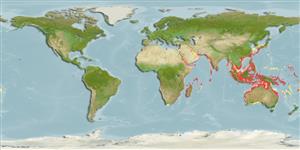Common names from other countries
>
Ovalentaria/misc (Various families in series Ovalentaria) >
Ambassidae (Asiatic glassfishes)
Etymology: Ambassis: Derived from Greek, anabasis = climbing up (Ref. 45335).
More on author: Lacepède.
Issue
Considered as a nomen dubium by Anderson & Heemstra, 2003 (Ref. 50956:200); no types known and illustration and description were found undiagnostic.
Environment: milieu / climate zone / depth range / distribution range
Οικολογία
Θαλασσινό(ά); Γλυκού νερού; Υφάλμυρο βενθικό(ς); pH range: 7.2 - 8.2; αμφίδρομο (Ref. 51243). Tropical; 22°C - 28°C (Ref. 12468)
Indo-West Pacific: South and East Africa, including Mauritius, Réunion, Madagascar and Seychelles, to Philippines, north to India, south to northern Australia (Ref. 33390). Extends south on African coast at least to Algoa Bay, South Africa (Ref. 4318).
Μέγεθος / Βάρος / Age
Maturity: Lm ? range ? - ? cm
Max length : 16.0 cm TL αρσενικό/απροσδιόριστο; (Ref. 4180)
Ραχιαίες άκανθες (συνολικά) : 7 - 8; Μαλακές ραχιαίες ακτίνες (συνολικά) : 8 - 10; Εδρικές άκανθες: 3; Μαλακές εδρικές ακτίνες: 8 - 10.
Fairly common in marine and fresh waters (Ref. 4180); found in shallow waters; common in estuaries; may enter lower reaches of rivers. Can tolerate fresh water only within a narrow temperature (23-26°C). Feeds mainly at night on crustaceans, but also takes small fishes, fish eggs and larvae in estuaries (Ref. 7248). Marketed dried, salted and fresh (Ref.97399).
Life cycle and mating behavior
Maturities | Αναπαραγωγή | Spawnings | Egg(s) | Fecundities | Προνύμφες
Maugé, L.A., 1986. Ambassidae. p. 297-298. In J. Daget, J.-P. Gosse and D.F.E. Thys van den Audenaerde (eds.) Check-list of the freshwater fishes of Africa (CLOFFA). ISNB, Brussels; MRAC, Tervuren; and ORSTOM, Paris. Vol. 2. (Ref. 4180)
IUCN Red List Status (Ref. 130435)
CITES (Ref. 128078)
Not Evaluated
Threat to humans
Harmless
Human uses
αλιεία: περιορισμένης εμπορικότητας; δόλωμα: occasionally
Εργαλεία
Special reports
Download XML
Διαδικτυακές πηγές
Estimates based on models
Preferred temperature (Ref.
115969): 24.2 - 29.1, mean 28.1 (based on 1254 cells).
Phylogenetic diversity index (Ref.
82804): PD
50 = 0.5000 [Uniqueness, from 0.5 = low to 2.0 = high].
Bayesian length-weight: a=0.01318 (0.00743 - 0.02338), b=3.01 (2.86 - 3.16), in cm Total Length, based on LWR estimates for this species & Genus-body shape (Ref.
93245).
Τροφικό Επίπεδο (Ref.
69278): 3.9 ±0.56 se; based on food items.
Ελαστικότητα (Ref.
120179): Υψηλό, ελάχιστος χρόνος για διπλασιασμό πληθυσμού < 15 μήνες (k=1.20).
Fishing Vulnerability (Ref.
59153): Low vulnerability (12 of 100).
